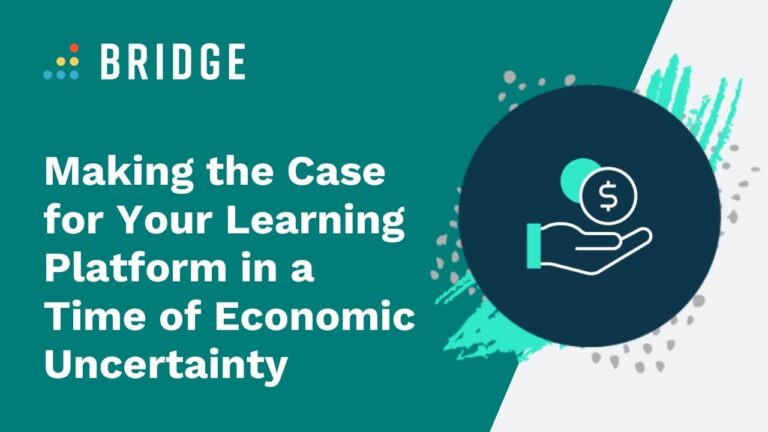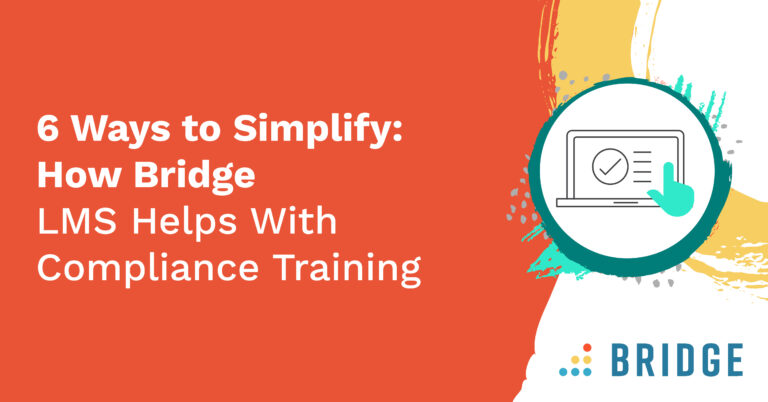Whenever economic uncertainty rears its head, thoughts will inevitably turn to cost savings and optimizations—and, for L&D teams, it’s the perfect time to gently remind business leaders that learning tools and programs are un-trimmable.
There’s a strong case to be made out of the sheer volume of eLearning that’s taking place in today’s business environments. In fact, according to a 2021 report from the UK’s Chartered Institute of Personnel and Development (CIPD), net investment in learning technologies increased by 25% in 2021—and, for larger companies, that figure is closer to 50%. On top of that, 69% of the CIPD’s respondents also reported that they’re innovating in their use of learning tech, and 77% believe they’re using it successfully.
On the other hand, any increase in the use of this tech can be seen as a double-edged sword: if there’s plenty of investment in learning tech being thrown around, some executives may consider it all the riper for cutting. In turbulent economic times, however, it’s all the more important to recognize how employers are using their learning technologies.
According to previous CIPD reports, high-performing businesses no longer see learning as a cost, but as a driver of revenue and business value. In other words, they invest in learning tech just as they’d invest in anything else: with the expectation of a return.
By framing your LMS as an investment to be leveraged—rather than a cost to be cut—you’ll be able to protect your core L&D program from the red pen that often appears around the start of an economic downturn.
The Economic Benefits of an Upskilled Workforce
As IBM has pointed out, skills are increasingly viewed in terms of their sell-by date: depending on the field, a skill can become redundant (or at least in need of refreshing) in anything from two and a half to five years.
This issue is magnified when workforces are cut. Your remaining workers will need to tackle a still-substantial workload, making up-to-date skills all the more essential. In fact, when faced with a high volume of work and limited resources, it’s never been more important to invest in skill building programs and ensure that your workers are fully upskilled for the challenges ahead.
Though these facts alone is reason enough to maintain your LMS and learning programs no matter the economic circumstances, it would be a mistake to think of learning as nothing more than a means of keeping your people’s capabilities ticking over. Instead, L&D can be thought of as a means of driving or creating tangible business value, and skills training is a great way to see that value in action.
The benefits of upskilling may be difficult to quantify on a granular level, but that doesn’t mean they don’t exist. In fact, a report produced by PwC and the World Economic Forum has been able to translate the large-scale value of upskilling efforts into dollars and cents.
According to PwC’s model, if countries upskill their workforces in accordance with OECD industry best practices by 2030, the global economy will experience a boost to the tune of $5 trillion.
Clearly, your LMS and skills development programs aren’t an expense to be withdrawn at the first sign of economic trouble—they’re instead a potent means of generating value.
In order to establish some of the more localized business benefits of skills training, it’s worth drilling down on the retention-, productivity-, and compliance-related advantages that your LMS has to offer.
WANT TO BOOST YOUR LEARNING RESOURCES? | ‘How To Get Your CEO To Increase L&D Budgets’
Increased Employee Retention
It might be counterintuitive to think of employee retention in economically tricky times. After all, this kind of backdrop is usually accompanied by workforce cuts and team downsizing—a far cry from maintaining workforces.
However, economic uncertainty won’t last forever—and at least part of your mitigation strategy needs to account for the state of your organization after the economic skies start to clear.
As Josh Bersin points out, companies can take years to ‘recover’ from layoffs. In fact, companies that choose to cut their workforces during recessions can find it difficult to find their feet when the economy picks up again. Bersin himself is credited with the oft-cited statistic that the cost of losing an employee is twice their annual salary—a cost that usually takes the form of lost productivity.
In short: money spent on employee retention will prevent financial losses in the long run. And it’s well documented that a robust learning program, backed up by a first-class LMS, is a fantastic way to foster your employees’ desire to stick with your organization. In fact, the right approach will do more than encourage retention. Learning is equally capable of galvanizing employees into new levels of productivity and engagement—provided it’s paired with the right incentives.
According to LinkedIn’s Workplace Learning Report 2022, learning is increasingly being connected to retention via career pathing. By setting your people up with the skills they need to succeed and advance within your organization, you’ll create a powerful incentive to ensure they’ll continue lending you their talents.
McKinsey tells a similar story in a report which suggests that skills-based learning practices enable internal mobility and—as a result—boost employee retention rates.
Against a backdrop of economic slowdown, learning is the engine for employee growth and forward momentum. There’s no question that professional success prompts degrees of engagement and productivity that can pull your organization through any economic storms and allow you to face the subsequent recovery period with cheerful resilience.
MORE ABOUT REDUCING TURNOVER | ‘5 Ways to Improve Employee Retention Rate in 2022’
Maintaining L&D Robustness In Case of Budget Reductions
In some cases, no matter how engaged your people are or how incentivized they may be, cutbacks to your L&D program will be unavoidable in the face of economic pressures.
However, just because your L&D team is operating with limited resources doesn’t mean you can’t deliver an impactful learning program for your wider workforce.
The right managed learning services, for example, will supplement your reduced workforce by lending the expertise required to build, manage, and deliver training programs.
Alternatively, if budget cuts have left you struggling to juggle central business priorities with department-specific training, you might be able to leverage the untapped potential of your own employees. After all, your organization is brimming with individuals who have the experience and expertise to create highly useful learning and training resources.
When paired with the right tools, employee-generated training is a great way to quickly capture and share the knowledge of your in-house specialists. Video capture and sharing tools, for example, will allow your experts to immediately explain a given concept or business process, while learners will find the friendly face of a colleague more engaging.
Similarly, if your LMS supports native or advanced course authoring, your in-house experts will be able to put together simple courses with minimal hassle. As a result, your people will enjoy great learning experiences that don’t strain an already stretched budget. You’ll also be offering your learners knowledge that’s more relevant and useful to their work.
Compliance Training: More Than A Nice-to-Have
Even the strictest fat-trimming CFOs will concede that L&D offers one undeniably essential function: compliance training. In fact, Thompson Reuters’ 2022 report on the subject names tight budgets as one of the biggest challenges for ensuring business compliance.
The need for compliance training extends beyond the obvious parameters of regulatory necessity. While avoiding fines and sanctions is still an essential, compliance training—like many aspects of L&D—should be seen as an investment that can yield multiple rewards.
Just look at Deloitte’s New horizons: Compliance 2020 and beyond report, which points out that—far from being limited to rules and regulations—compliance is the key to unlocking benefits like:
- Cross-organization synergies and efficiencies
- A more ethical workplace and business culture
- An emphasis on new levels of effective communication
These advantages aren’t dissimilar to the broader benefits of investing in L&D as a whole. Deloitte’s description of compliance driving efficiency and a strong culture could equally be said of the learning programs that foster employee retention, engagement, and productivity. These are all factors that should be treated with extra respect in a time of economic uncertainty.
As such, recognizing the must-have qualities of compliance training should make us question whether the rest of L&D should be consigned to the ‘nice-to-have’ label. This question is particularly urgent in a working world increasingly defined by skills gaps and talent shortages, whatever the economic situation may be.
This attitude is already starting to take hold. Linkedin Learning found that 64% of L&D professionals feel that, in 2021, L&D transformed from a ‘nice-to-have’ to a ‘need-to-have’.
When it comes to budget cuts, the distinctions between ‘nice’ and ‘must’ are well worth identifying—and investing in the right learning tools is an essential way to help your organization survive and thrive, both within a tricky economy and beyond.
RELATED READING | ‘5 Tips and Tools To Optimize Your Compliance Training’
Justify Your Learning Investments With Bridge
If you want to feel the return on your LMS investments and watch your employees unlock their productive potential, you can’t go wrong with Bridge. Bridge’s LMS allows you to deliver the right training at the right time.
Thanks to its native course authoring, advanced video functionality, and easy-to-use interface, Bridge ensures that your people will be equally comfortable whether they’re generating or absorbing that all-important learning content.



